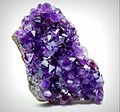National symbols of South Korea
Appearance
This article needs additional citations for verification. (November 2024) |
 |
| Part of a series on the |
| Culture of Korea |
|---|
| Society |
| Arts and literature |
| Other |
| Symbols |
|
The national symbols of South Korea are official and unofficial flags, icons, or cultural expressions that are emblematic, representative, or otherwise characteristic of South Korea (the Republic of Korea) and of its culture. Since the division of the Korean peninsula in 1948, South Korea has retained traditional symbols to distinguish from the national symbols of North Korea.
Symbols
[edit]| Symbol | Image | Notes | |
|---|---|---|---|
| Flag | Flag of South Korea |  |
Current version, adopted in 2011; inaugural version from 1948. |
| Emblem | Emblem of South Korea |  (Taegeuk; Hibiscus syriacus) |
The original version of the emblem was announced on 10 December 1963;[1][2][3][4] the current version (shown here) was adopted in 2011. |
| National anthem | Aegukga 애국가 |
 |
|
| Song | Arirang 아리랑 |
||
| Seal | National seal Guksae |

|
Current version, adopted in 2011; inaugural version was adopted in 1949. |
| Governmental emblem | Government emblem of South Korea (Taegeuk) |
 |
|
| National motto | 홍익인간 (弘益人間) | "Benefit broadly in the human world / Devotion to the Welfare of Humanity" |
|
| National tree | Korean red pine (Pinus densiflora) |
 |
|
| National flower | Mugunghwa |  |
|
| National bird | Korean magpie (Pica sericea) |
 |
|
| National animal | Korean tiger (Panthera tigris tigris) |
 |
|
| National fruit | Asian Pear (Pyrus pyrifolia) |
 |
|
| National currency | South Korean won | ||
| Patron saint | Andrew Kim Taegon | 
|
|
| National founder | Dangun | 
|
|
| De facto | Ch'oe Ch'i-wŏn, Han Yong-un, Pak Mok-wol, Jeong Cheol |  |
|
| National epic | Jewang Un'gi, King Dongmyeong |  |
|
| De facto | Buchaechum, Ganggangsullae, Geommu |  |
|
| National costume | Hanbok | 
|
|
| National insect | Callipogon relictus |  |
Unofficial symbol of the Entomological Society of Korea and Korean Entomological Institute |
| National instrument | Gayageum | ||
| National stone | Amethyst |  |
|
| National colours | White Red Blue Black |
||
| National mountains | Paektu Mountain, Hallasan |   |
Paektu Mountain is located in North Korea and China Both are part of the larger Baekdu-daegan |
| National sport | Taekwondo |  |
|
| National dish | Kimchi |  |
|
| National liquor | Makgeolli |  |
References
[edit]- ^ Ministry of the Interior of the Republic of Korea (2017). National Symbols of the Republic of Korea: Uniting People and Elevating National Pride. Seoul: Ministry of the Interior of the Republic of Korea. pp. 10–11. Archived from the original on 6 August 2017. Retrieved 1 December 2024.
- ^ "우리나라 국가상징> 나라문장".
- ^ Myers, Brian Reynolds (2011). "North Korea's state-loyalty advantage". Free Online Library. Archived from the original on 20 May 2018. Retrieved 20 May 2018.
The state emblem (adopted in 1963) is a taegeuk symbol on a rose of Sharon--another purely racial symbol.
- ^ 관보 [Official Gazette]. Government of the Republic of Korea. 10 December 1963. pp. 25–26. Retrieved 5 July 2024.

